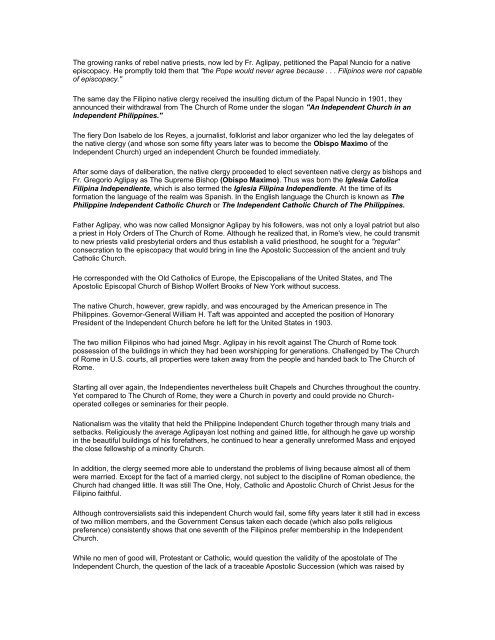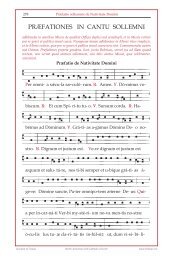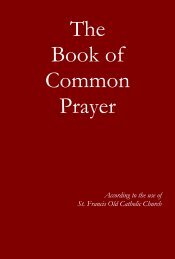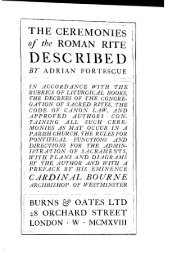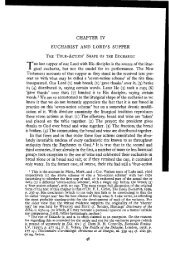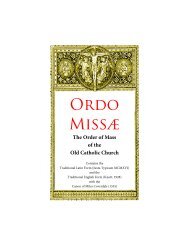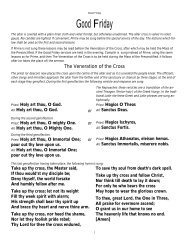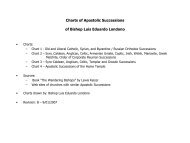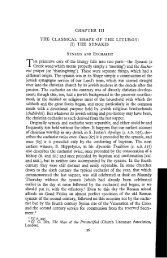Official Record of Apostolic Succession of
Official Record of Apostolic Succession of
Official Record of Apostolic Succession of
Create successful ePaper yourself
Turn your PDF publications into a flip-book with our unique Google optimized e-Paper software.
The growing ranks <strong>of</strong> rebel native priests, now led by Fr. Aglipay, petitioned the Papal Nuncio for a native<br />
episcopacy. He promptly told them that "the Pope would never agree because . . . Filipinos were not capable<br />
<strong>of</strong> episcopacy."<br />
The same day the Filipino native clergy received the insulting dictum <strong>of</strong> the Papal Nuncio in 1901, they<br />
announced their withdrawal from The Church <strong>of</strong> Rome under the slogan "An Independent Church in an<br />
Independent Philippines."<br />
The fiery Don Isabelo de los Reyes, a journalist, folklorist and labor organizer who led the lay delegates <strong>of</strong><br />
the native clergy (and whose son some fifty years later was to become the Obispo Maximo <strong>of</strong> the<br />
Independent Church) urged an independent Church be founded immediately.<br />
After some days <strong>of</strong> deliberation, the native clergy proceeded to elect seventeen native clergy as bishops and<br />
Fr. Gregorio Aglipay as The Supreme Bishop (Obispo Maximo). Thus was born the Iglesia Catolica<br />
Filipina Independiente, which is also termed the Iglesia Filipina Independiente. At the time <strong>of</strong> its<br />
formation the language <strong>of</strong> the realm was Spanish. In the English language the Church is known as The<br />
Philippine Independent Catholic Church or The Independent Catholic Church <strong>of</strong> The Philippines.<br />
Father Aglipay, who was now called Monsignor Aglipay by his followers, was not only a loyal patriot but also<br />
a priest in Holy Orders <strong>of</strong> The Church <strong>of</strong> Rome. Although he realized that, in Rome's view, he could transmit<br />
to new priests valid presbyterial orders and thus establish a valid priesthood, he sought for a "regular"<br />
consecration to the episcopacy that would bring in line the <strong>Apostolic</strong> <strong>Succession</strong> <strong>of</strong> the ancient and truly<br />
Catholic Church.<br />
He corresponded with the Old Catholics <strong>of</strong> Europe, the Episcopalians <strong>of</strong> the United States, and The<br />
<strong>Apostolic</strong> Episcopal Church <strong>of</strong> Bishop Wolfert Brooks <strong>of</strong> New York without success.<br />
The native Church, however, grew rapidly, and was encouraged by the American presence in The<br />
Philippines. Governor-General William H. Taft was appointed and accepted the position <strong>of</strong> Honorary<br />
President <strong>of</strong> the Independent Church before he left for the United States in 1903.<br />
The two million Filipinos who had joined Msgr. Aglipay in his revolt against The Church <strong>of</strong> Rome took<br />
possession <strong>of</strong> the buildings in which they had been worshipping for generations. Challenged by The Church<br />
<strong>of</strong> Rome in U.S. courts, all properties were taken away from the people and handed back to The Church <strong>of</strong><br />
Rome.<br />
Starting all over again, the Independientes nevertheless built Chapels and Churches throughout the country.<br />
Yet compared to The Church <strong>of</strong> Rome, they were a Church in poverty and could provide no Churchoperated<br />
colleges or seminaries for their people.<br />
Nationalism was the vitality that held the Philippine Independent Church together through many trials and<br />
setbacks. Religiously the average Aglipayan lost nothing and gained little, for although he gave up worship<br />
in the beautiful buildings <strong>of</strong> his forefathers, he continued to hear a generally unreformed Mass and enjoyed<br />
the close fellowship <strong>of</strong> a minority Church.<br />
In addition, the clergy seemed more able to understand the problems <strong>of</strong> living because almost all <strong>of</strong> them<br />
were married. Except for the fact <strong>of</strong> a married clergy, not subject to the discipline <strong>of</strong> Roman obedience, the<br />
Church had changed little. It was still The One, Holy, Catholic and <strong>Apostolic</strong> Church <strong>of</strong> Christ Jesus for the<br />
Filipino faithful.<br />
Although controversialists said this independent Church would fail, some fifty years later it still had in excess<br />
<strong>of</strong> two million members, and the Government Census taken each decade (which also polls religious<br />
preference) consistently shows that one seventh <strong>of</strong> the Filipinos prefer membership in the Independent<br />
Church.<br />
While no men <strong>of</strong> good will, Protestant or Catholic, would question the validity <strong>of</strong> the apostolate <strong>of</strong> The<br />
Independent Church, the question <strong>of</strong> the lack <strong>of</strong> a traceable <strong>Apostolic</strong> <strong>Succession</strong> (which was raised by


